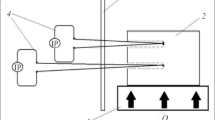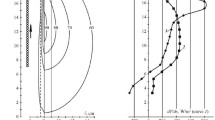A review is provided for processes that occur within refractory concrete during hydration and heating. Theoretical data are referred to practical cases connected with concrete explosive cracking. On the basis of physicochemical behavior of concrete with high-temperature heating and thermotechnical calculation it is possible to correct a heating curve in order to prevent concrete lining breakage during warm-up.





Similar content being viewed by others
References
F. A. Cardoso, V. C. Pandolfelli, et al., “Effect of curing time on the properties of CAC bonded refractory castables,” J. Europ. Ceram. Soc. (2003).
C. Wochrmeyer, C. Parr, et al., “Impact of hydration and dehydration conditions on the permeability of LCC system,” Unitecr, p. 8 (2007).
C. Parr, “Calcium aluminate cement – what happens when things go wrong?” IRE Annual Conf., Rotherham UK, No. 9, 11 (2008).
M. D. M. Innocentini, A. R. Studart, et al., “The drying behavior of high-alumina ULC refractory castables under different heating rates,” Refractory Application and News., 7, No.5, 17–20 (2002).
P. Meunier, J. C. Mindeguia, and P. Pimienta, “Mass, temperature and pressure measurements during the dry out of refractory castables,” 51st Internat. Coll. On Refractories, Aachen, Germany (2008).
J. Zimmermann and O. Krouse, “Phase evolution of calcium aluminate cemented refractory castables at temperatures exceeding 1000°C,” FGF – Forschungsgemainschaft Feurfest e. V., Bonn, Germany, 51st Internat. Coll. On Refractories – Refractories for Metallurgy.
J. M. Canon, T. P. Sander, J. D. Smith, et al., “Effect of organic fiber editions on permeability of refractory concrete,” UNITECR’1997.
S. Starikov, M. V. Temlyantsev, and V. V. Starikov, Refractories and Linings in Ladle Metallurgy: Teaching for Higher Education Establishments [in Russian], MISiS, Moscow (2003).
Author information
Authors and Affiliations
Additional information
Translated from Novye Ogneupory, No. 1, pp. 27 – 33, January 2011.
Rights and permissions
About this article
Cite this article
Belousova, V.Y., Chernikov, A.V. Heating of a steel-pouring ladle bottom concrete lining under workshop conditions. Refract Ind Ceram 52, 23–28 (2011). https://doi.org/10.1007/s11148-011-9357-2
Received:
Published:
Issue Date:
DOI: https://doi.org/10.1007/s11148-011-9357-2




